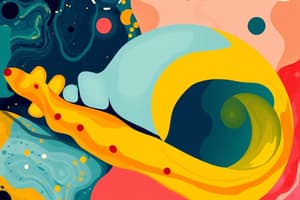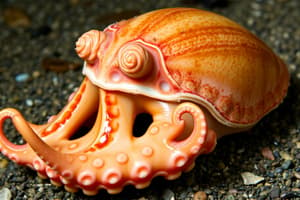Podcast
Questions and Answers
What is the primary function of the radula in snails?
What is the primary function of the radula in snails?
- To filter particles of food from water
- To grasp and manipulate food (correct)
- To secrete the shell
- To burrow into the sea bottom
What is unique about the respiratory system of pulmonates?
What is unique about the respiratory system of pulmonates?
- They have a book-lung for respiration
- They have a lung for respiration (correct)
- They have gills for respiration
- They use their radula for gas exchange
What is the composition of the shell in snails?
What is the composition of the shell in snails?
- Protein and keratin
- Silica and calcium carbonate
- Calcium carbonate only (correct)
- Chitin and calcium carbonate
What is the larval stage of snails?
What is the larval stage of snails?
What is the primary mode of feeding in bivalves?
What is the primary mode of feeding in bivalves?
What is the characteristic feature of the circulatory system in mollusks?
What is the characteristic feature of the circulatory system in mollusks?
Where does the larval stage of Trichinella occur?
Where does the larval stage of Trichinella occur?
What is the function of radula in snails and chitons?
What is the function of radula in snails and chitons?
What is a characteristic of chitons?
What is a characteristic of chitons?
What is the location of the adult Trichinella parasite in humans?
What is the location of the adult Trichinella parasite in humans?
What is a feeding behavior of some Molluscs?
What is a feeding behavior of some Molluscs?
How do some land-dwelling Molluscs breathe?
How do some land-dwelling Molluscs breathe?
What is the primary mode of locomotion for squids and octopuses?
What is the primary mode of locomotion for squids and octopuses?
Which of the following is a characteristic of annelids?
Which of the following is a characteristic of annelids?
What is unique about the circulatory system of squids and octopuses?
What is unique about the circulatory system of squids and octopuses?
What is the main function of the parapodia in polychaetes?
What is the main function of the parapodia in polychaetes?
What is the main difference between polychaetes and earthworms?
What is the main difference between polychaetes and earthworms?
What is the function of the radula in squids and octopuses?
What is the function of the radula in squids and octopuses?
Flashcards are hidden until you start studying
Study Notes
Cephalopoda (Squids & Octopuses)
- Advanced active predators with a streamlined body and stabilizing fins
- Fast swimmers using jet propulsion, squirting a jet of water out of the mantle cavity
- Excellent eyesight and very large brain, making them highly intelligent
- Well-developed closed blood system with a double circulation and three hearts
- Foot replaced by 10 tentacles covered in suckers to hold slippery fish
- Inject poison to kill fish, then cut them up with a pair of jaws and use radula to pull pieces into the mouth
Annelida (Segmented Worms)
- Tubular body divided into segments, an adaptation for burrowing
- Burrow using a hydrostatic skeleton, with a water-filled coelom enclosed in two layers of muscles
- Well-developed closed blood system with arteries, veins, and five hearts
- Have a dorsal brain, ventral nerve, and ganglia in each segment
- Excretion by metanephridia
- Breathe through the skin
- Have a clitellum that aids in reproduction
Annelid Classes
- Polychaeta: most primitive, live in the sea, and crawl over the sea bottom using parapodia and chaetae on each segment
- Oligochaeta (Earthworms): live on land or in freshwater, adapted for burrowing, and have no parapodia and no head
Mollusca (Snails)
- More advanced phylum with a coelom and true gut
- Characteristics:
- Shell of CaCO3
- Body divided into: head, foot, mantle (secretes shell), and visceral mass
- Radula: a chitin rod covered in rows of teeth, used for feeding
- Only sexual reproduction (dioecious): egg → ciliated trochophore larva
- Advanced nervous system (brain + separate nerves), but primitive blood system (open blood circulatory system with haemocoel)
Molluscan Classes
- Bivalves: mainly live in the sea, burrow in the sea bottom using a wedge-shaped foot, and have a shell with 2 valves completely enclosing the body
- Chitons (Polyplacophora): most primitive, live in the sea, and have a shell consisting of 8 plates
- Snails (Gastropoda): large diverse group, crawl using a large flat foot, and have a distinct head with tentacles and eyes
Nematoda (Round Worms)
- Trichinella has its larval stage in pigs (secondary host), and can enter humans through eating infected pork
- The adult is an intracellular parasite inside a skeletal muscle cell, and secretes chemicals to:
- Cause the skeletal muscle cell to expand
- Attract blood vessels to the cell to improve its O2 supply
Studying That Suits You
Use AI to generate personalized quizzes and flashcards to suit your learning preferences.




